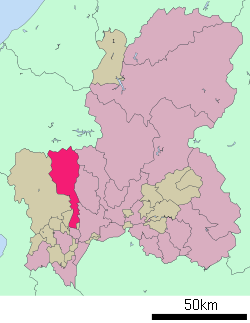Motosu, Gifu
| Motosu 本巣市 | |||
|---|---|---|---|
| City | |||
 Motosu City Hall | |||
| |||
 Location of Motosu in Gifu Prefecture | |||
 Motosu | |||
| Coordinates: 35°28′58.8″N 136°40′43.1″E / 35.483000°N 136.678639°ECoordinates: 35°28′58.8″N 136°40′43.1″E / 35.483000°N 136.678639°E | |||
| Country | Japan | ||
| Region | Chūbu | ||
| Prefecture | Gifu | ||
| Government | |||
| • Mayor | Tsutomu Fujiwara[1] | ||
| Area | |||
| • Total | 89.04 km2 (34.38 sq mi) | ||
| Population (October 1, 2017) | |||
| • Total | 33,507 | ||
| • Density | 380/km2 (970/sq mi) | ||
| Time zone | UTC+9 (Japan Standard Time) | ||
| City symbols | |||
| - Tree | Persimmon | ||
| - Flower | Usuzumi cherry blossom | ||
| - Bird | Japanese bush-warbler | ||
| - Fish | Ayu | ||
| Phone number | 0581-34-2511 | ||
| Address | 324 Monju, Motosu-shi, Gifu-ken 501-1292 | ||
| Website | Official website | ||

Motosu (本巣市 Motosu-shi) is a city located in Gifu, Japan. As of 1 October 2017, the city had an estimated population of 33,507, and a population density of 380 persons per km2. The total area of the city was 117.01 square kilometres (45.18 sq mi).
Geography
Motosu is located in western Gifu Prefecture. Mount Nōgōhaku, on the border between Motosu and Fukui Prefecture is the highest point in the city, with an elevation of 1,116 metres (3,661 ft).
Climate
The city has a climate characterized by characterized by hot and humid summers, and mild winters (Köppen climate classification Cfa). The average annual temperature in Motosu is 15.1 °C. The average annual rainfall is 2054 mm with September as the wettest month. The temperatures are highest on average in August, at around 27.7 °C, and lowest in January, at around 3.6 °C.[2]
Neighbouring municipalities
Demographics
Per Japanese census data,[3] the population of Motosu has increased gradually over the past 40 years..
| Census Year | Population |
|---|---|
| 1970 | 24,943 |
| 1980 | 28,245 |
| 1990 | 32,828 |
| 2000 | 33,900 |
| 2010 | 35,047 |
City symbols
Motosu city's tree is the persimmon tree, which is found growing naturally in the mountainous areas of Motosu. As persimmons are also cultivated in Motosu, it was chosen to represent the agricultural industry in the area.
The city flower is the usuzumi cherry blossom found in the recently merged Neo. This unique cherry blossom initially sprouts pale pink flowers, which become white in full bloom, and a light black colour when the flowers die. Neo is also home to one of the three largest cherry blossom trees in Japan, which is reported to be the oldest cherry blossom tree in Japan.
Ayu or sweetfish, has been chosen to be the representative fish of the city. Known as "the queen of clear streams", the fish is found in the Neo River that flows through Motosu. Highly regarded for its flavour in Japan, it is fished throughout summer in the rivers.
The Motosu city bird is the uguisu sparrow, found in shrub thickets throughout Motosu. The sparrow is known for its greenish brown colouring on its back, and white belly. Female birds can also be recognised by their dash pattern on their backs. It is also known as the bush warbler or "flower-viewing" bird, for its appearance near the many cherry blossom trees in the area.
In order to commemorate the three-year anniversary Motosu-city's amalgamation of Itonuki, Neo, Shinsei and Motosu, the municipal government began working on a theme song that best represented their vision of the future. The lyrics of the theme song, "Habataite", are intended to convey the ideas of nature and people living harmoniously together. The song is played every afternoon on the loudspeakers to warn children to return home before nightfall. The music was written by the world-renowned ocarina player Soujirou, who was commissioned by the local city government to write the theme song.
History
The area around Motosu was part of traditional Mino Province. During the Edo period, much of the area was under the control of Ogaki Domain under the Tokugawa shogunate. In the post-Meiji restoration cadastral reforms, Motosu District in Gifu prefecture was created.
On October 28, 1891, the Mino–Owari earthquake, the second largest earthquake to hit Japan, struck. Its epicenter was located in Motosu.
The modern city of Motosu was established on February 1, 2004, from the merger of the former town of Motosu, absorbing the towns of Itonuki and Shinsei, and the village of Neo (all from Motosu District).
Government
Motosu has a mayor-council form of government with a directly elected mayor and a unicameral city legislature of 18 members.
Economy
On April 29, 2006, Malera Gifu opened on Mitsuhashi, one of the main roads of Motosu. This shopping centre covers an area of 185,000 m2, making it one of the largest shopping centres in Japan. It houses approximately 240 retail outlets, including a supermarket (Valor), restaurants, clothes retailers and a cinema (Toho Cinema).
Education
Colleges and universities
Primary and secondary education
Motosu has eight public elementary schools and four public middle schools operated by the city government. The city has one public high school operated by the Gifu Prefectural Board of Education, and one private high school (Gifu Daiichi High School).
Transportation
Railway
- Tarumi Railway Tarumi Line
- Kitagata-Makuwa - Morera-Gifu - Itonuki - Motosu - Oribe - Kochibora - Tanigumi-guchi - Kōmi - Takashina - Nabera - Hinata - Takao - Midori - Tarumi
Highway
References
- ↑ 市長プロフィール. Motosu official page (in Japanese). Retrieved 10 August 2011.
- ↑ Motosu climate data
- ↑ Motosu population statistics
External links
| Wikimedia Commons has media related to Motosu, Gifu. |
- Motosu City official website (in Japanese)
- Malera official website (in Japanese)
